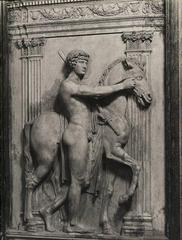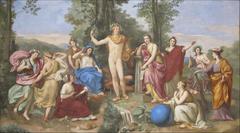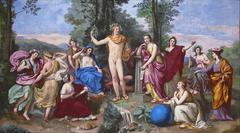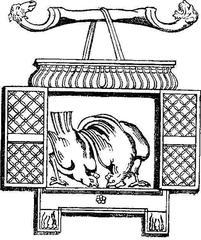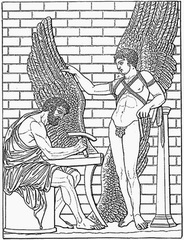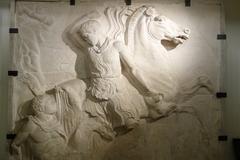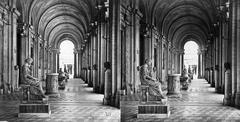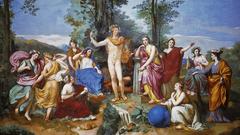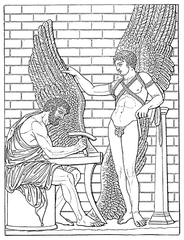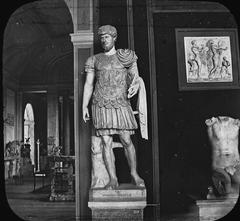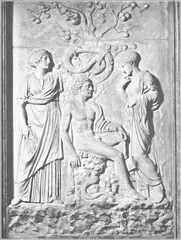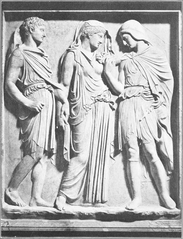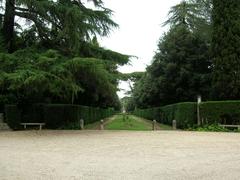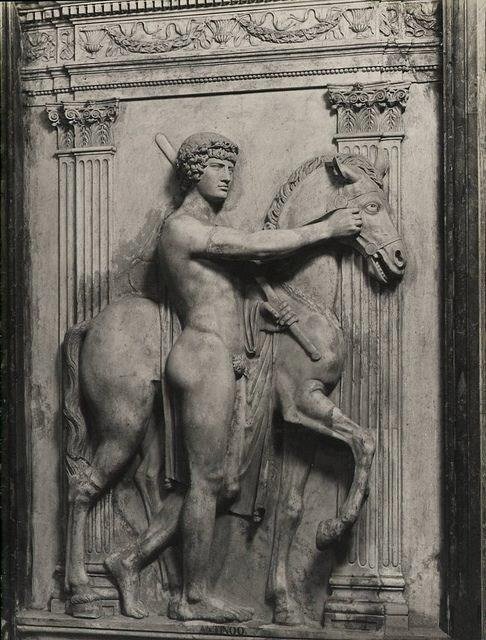
Villa Albani Rome: Visiting Hours, Tickets, and Travel Guide
Date: 14/06/2025
Introduction
Villa Albani Torlonia, located in Rome’s Nomentano district, is an exceptional example of 18th-century neoclassical architecture and a treasure trove of classical art. Commissioned by Cardinal Alessandro Albani and designed by Carlo Marchionni, the villa is renowned for its harmonious blend of architecture, landscape, and antiquities. Today, under the stewardship of the Torlonia family and the Fondazione Torlonia, the villa remains both an exclusive cultural landmark and an essential destination for lovers of history, art, and architecture (Fondazione Torlonia, Finestre sull’Arte, Gazette Drouot).
This comprehensive guide provides detailed information on Villa Albani’s history, collection, visiting hours, ticket booking, accessibility, and travel tips, ensuring you make the most of your visit.
Table of Contents
- Origins and Construction
- The Albani “Cenacle” and Neoclassicism
- Architectural and Artistic Features
- The Torlonia Family Era
- Antiquarianism and the Grand Tour
- Visiting Villa Albani Torlonia: Hours, Tickets, and Accessibility
- Highlights of the Collection
- Special Events and Cultural Impact
- Visitor Experience and Conduct
- Accessibility and Facilities
- Nearby Attractions and Travel Tips
- Frequently Asked Questions (FAQ)
- Summary & References
Origins and Construction
Villa Albani Torlonia was conceived during the height of Rome’s Enlightenment as a retreat and display space for Cardinal Alessandro Albani’s extensive collection of antiquities. Built between 1747 and 1767, the villa was designed by Carlo Marchionni, who worked closely with Albani and a distinguished group of intellectuals and artists. The site, formerly countryside outside Rome’s walls, was transformed into a terraced landscape, featuring perspective axes that visually connect the villa with the Sabine and Alban Hills (Fondazione Torlonia).
The Albani “Cenacle” and the Rise of Neoclassicism
Villa Albani quickly became a center of intellectual and artistic exchange, hosting luminaries such as Johann Joachim Winckelmann, Giovanni Battista Piranesi, and Giovanni Battista Nolli. Winckelmann, often considered the father of modern art history, played a crucial role in arranging and interpreting the villa’s collections, fostering the emergence of neoclassicism and influencing the Grand Tour tradition (Fondazione Torlonia).
Architectural and Artistic Features
The villa’s main building, or casino nobile, is flanked by loggias and pavilions, set within gardens structured around principal axes lined with holm oaks and umbrella pines. The integration of architecture, sculpture, and landscape is intentional, offering “emotional paths” for visitors as they experience carefully curated displays of ancient sculptures, bas-reliefs, and fountains. The interiors are adorned with frescoes, stuccoes, and decorative schemes exemplifying 18th-century taste and Enlightenment ideals (Fondazione Torlonia).
The Torlonia Family Era
In 1866, the Torlonia family acquired the villa, expanding and restoring both the grounds and the art collections. The Torlonias maintained the estate’s legacy as a center of learning and culture, and the villa even played a role in Italian political history, hosting the signing of the Capture of Rome in 1870. The façade’s inscription honors both founder and restorer (Fondazione Torlonia):
Alexander Albani vir eminentissimus instruxit et ornavit / Alexander Torlonia vir princeps in melius restituit.
Antiquarianism and the Grand Tour
Villa Albani was an essential stop for 18th and 19th-century European aristocrats, scholars, and artists undertaking the Grand Tour. The villa’s display and interpretation of antiquities—guided by Winckelmann’s scholarly approach—set new standards for museums and collections across Europe, emphasizing historical context and educational value alongside artistic appreciation (Fondazione Torlonia).
Visiting Villa Albani Torlonia: Hours, Tickets, and Accessibility
Booking and Access
- Advance Booking Required: The villa is not open for walk-in visits. Access is by appointment only and must be requested via the Fondazione Torlonia official website or by direct contact with the administration. A request form and confirmation are required.
- Group Size: Visits are limited to small groups (generally up to 10 people). All participant names must be submitted in advance.
- Tour Format: All visits are guided by expert art historians. There are no written labels or signage; the guide provides interpretive commentary throughout.
Visiting Hours and Ticket Pricing
- Typical Visiting Hours: Appointments are usually available Tuesday to Sunday, between 10:00 AM and 6:00 PM; some areas or events have morning-only sessions.
- Tickets: Prices range from €10–€15 for adults, with discounts for students and seniors. Guided tours may have separate rates. For special exhibitions (such as the 2025 Antiquarium), entrance may be free and open to the public during set hours (e.g., 9:00 AM to 1:00 PM) (Finestre sull’Arte).
Accessibility
- Physical Access: Some historic and terraced areas may be challenging for visitors with reduced mobility. Contact the foundation in advance for specific accommodations.
- Facilities: There are limited restroom facilities and no on-site cafés or shops. Plan accordingly.
Highlights of the Collection
- Ancient Sculptures: Includes masterpieces such as the bas-relief of Antinous and the “Dancing Faun.” The collection features Greek, Roman, and Etruscan works, many with provenances from sites like Villa Adriana.
- Paintings and Decorative Arts: Notable works by Perugino, Tintoretto, Giulio Romano, Jacques-Louis David, and frescoes such as the celebrated “Il Parnaso” by Anton Raphael Mengs.
- Garden Statues and Fountains: The gardens are adorned with strategically placed statuary and fountains, creating a narrative landscape.
- The Torlonia Collection: Now considered the world’s most important private assemblage of ancient sculpture, with more than 600 works (Finestre sull’Arte, Gazette Drouot).
Special Events and Cultural Impact
Villa Albani Torlonia continues to host cultural events, scholarly symposia, and special exhibitions. The Antiquarium exhibition space, inaugurated in 2025, offers free public access to a curated selection of ancient and modern sculptures. The villa’s international profile was elevated by events like the Dior Cruise 2026 fashion show (Kendam).
Ongoing restoration and digitization projects ensure the collection’s preservation and scholarly accessibility, with many works set to become available online in 2025 (Finestre sull’Arte).
Visitor Experience and Conduct
- Atmosphere: The villa offers a serene, contemplative environment, distinct from busier Roman museums.
- Visitor Conduct: Photography is strictly prohibited inside; visitors are expected to maintain quiet and respectful behavior.
- No Signage: The lack of written materials enhances focus on the guide’s narrative and the art itself.
Accessibility and Facilities
While the villa strives to accommodate visitors with reduced mobility, the historic architecture and terraced gardens limit full accessibility. There are no on-site cafés or gift shops, and restroom facilities are limited. Plan your visit accordingly, and consult the foundation for any special needs.
Nearby Attractions and Travel Tips
- Location: Via Salaria, 92, near Rome’s Aurelian Walls and Villa Borghese.
- Transport: Accessible by Metro (Line B to Libia or Policlinico), buses 62/309, or taxi.
- Combine Visits: Pair your visit with nearby attractions like the Borghese Gardens, the National Roman Museum, and local eateries in Piazza Bologna.
- Travel Tips: Book well in advance, wear comfortable shoes, and bring essentials.
Frequently Asked Questions (FAQ)
Q: How do I book a visit?
A: Bookings must be made through the Fondazione Torlonia website or by direct request. Walk-ins are not allowed.
Q: What are the usual visiting hours?
A: Appointments are typically available Tuesday–Sunday, 10:00 AM–6:00 PM, but may vary for special events.
Q: Is the villa accessible for disabled visitors?
A: Partial accessibility; contact the foundation ahead of time for assistance.
Q: Are children allowed?
A: Yes, but must observe quiet and respectful behavior.
Q: Is photography permitted?
A: No, to protect both the artwork and the contemplative atmosphere.
Summary
Villa Albani Torlonia stands as a beacon of classical heritage and Enlightenment ideals, offering a rare, expertly guided experience of Rome’s neoclassical art and architecture. Its exclusive access, world-renowned collection, and serene setting ensure an enriching visit for those who plan ahead. Combine your tour with nearby attractions to fully appreciate Rome’s cultural depth, and stay updated on ticketing and special events through official channels (Fondazione Torlonia, Finestre sull’Arte, Gazette Drouot, Kendam).
References and Further Reading
- Villa Albani Torlonia Official Site, Fondazione Torlonia Museum, 2025
- The Torlonia Collection Exhibition Announcement, Finestre sull’Arte, 2025
- Villa Albani Torlonia: A Roman Paradise, Gazette Drouot, 2024
- Dior Cruise 2026 Runway at Villa Albani, Kendam, 2025
Images courtesy of Fondazione Torlonia Museum.
